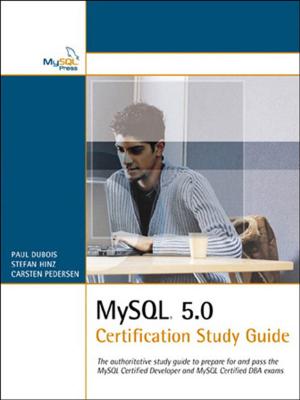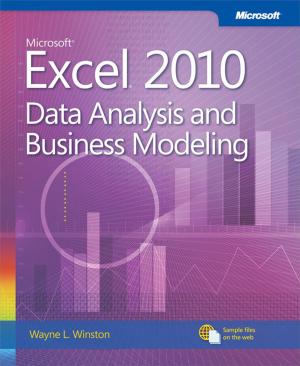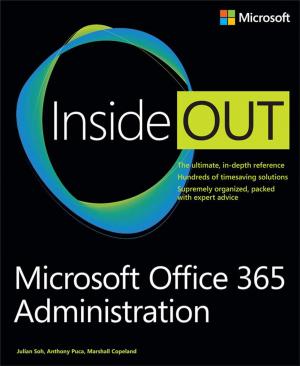| Author: | Jeffrey S. Beasley | ISBN: | 9780131363434 |
| Publisher: | Pearson Education | Publication: | September 3, 2008 |
| Imprint: | Prentice Hall Certification | Language: | English |
| Author: | Jeffrey S. Beasley |
| ISBN: | 9780131363434 |
| Publisher: | Pearson Education |
| Publication: | September 3, 2008 |
| Imprint: | Prentice Hall Certification |
| Language: | English |
Networking
Second Edition
Jeffrey S. Beasley
This text provides a comprehensive look at computer networking from the point of view of the network administrator. It guides readers from an entry-level knowledge in computer networks to advanced concepts in Ethernet networks; router configuration; TCP/IP networks; local-, campus-, and wide-area network configuration; network security; optical networks; voice over IP; and industrial networks. Extensive examples on the Windows Server 2003/2008 configuration and system configuration for the Linux operating system are also included. A complete chapter is devoted to protecting and securing a network from potential network attacks. Topics include denial of service attacks, firewalls, intrusion detection, password cracking, packet sniffing, and analyzing unsecured data packets. Other key network security issues, such as configuring router access lists, configuring a virtual private network (VPN) connection, and securing wireless networks, are also covered. Router configuration is examined, ranging from an introduction to router configuration to configuring multiple routing protocols for intranet and Internet data traffic. Routing protocols key to basic network operations are examined, including static, RIP, IGRP, OSPF, EIGRP, and BGP. The discussions on routing protocols are accompanied with in-depth steps for configuring the router to run the protocol, verify operation, and troubleshoot the router.
Key Pedagogical Features
- PROTOCOL ANALYZER SOFTWARE included with the text uses the Finisar Surveyor Demo. Examples of using the software to analyze data traffic are included throughout the text.
- CONFIGURING, ANALYZING, or TROUBLESHOOTING sections are included with each chapter to guide the reader through advanced techniques in networking.
- OBJECTIVES and INTRODUCTION at the beginning of each chapter clearly outline specific goals for the reader.
- EXTENSIVE PROBLEM SETS, SUMMARIES, and QUESTIONS AND PROBLEMS (including Critical Thinking questions) are found at the end of each chapter.
- KEY TERMS and their definitions are highlighted in the margins to foster inquisitiveness and ensure retention.
Networking
Second Edition
Jeffrey S. Beasley
This text provides a comprehensive look at computer networking from the point of view of the network administrator. It guides readers from an entry-level knowledge in computer networks to advanced concepts in Ethernet networks; router configuration; TCP/IP networks; local-, campus-, and wide-area network configuration; network security; optical networks; voice over IP; and industrial networks. Extensive examples on the Windows Server 2003/2008 configuration and system configuration for the Linux operating system are also included. A complete chapter is devoted to protecting and securing a network from potential network attacks. Topics include denial of service attacks, firewalls, intrusion detection, password cracking, packet sniffing, and analyzing unsecured data packets. Other key network security issues, such as configuring router access lists, configuring a virtual private network (VPN) connection, and securing wireless networks, are also covered. Router configuration is examined, ranging from an introduction to router configuration to configuring multiple routing protocols for intranet and Internet data traffic. Routing protocols key to basic network operations are examined, including static, RIP, IGRP, OSPF, EIGRP, and BGP. The discussions on routing protocols are accompanied with in-depth steps for configuring the router to run the protocol, verify operation, and troubleshoot the router.
Key Pedagogical Features
- PROTOCOL ANALYZER SOFTWARE included with the text uses the Finisar Surveyor Demo. Examples of using the software to analyze data traffic are included throughout the text.
- CONFIGURING, ANALYZING, or TROUBLESHOOTING sections are included with each chapter to guide the reader through advanced techniques in networking.
- OBJECTIVES and INTRODUCTION at the beginning of each chapter clearly outline specific goals for the reader.
- EXTENSIVE PROBLEM SETS, SUMMARIES, and QUESTIONS AND PROBLEMS (including Critical Thinking questions) are found at the end of each chapter.
- KEY TERMS and their definitions are highlighted in the margins to foster inquisitiveness and ensure retention.















